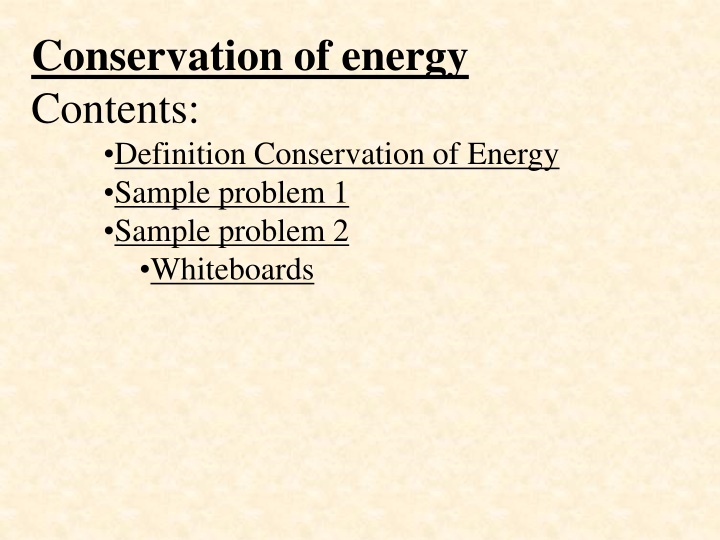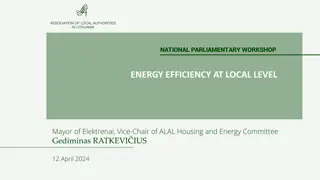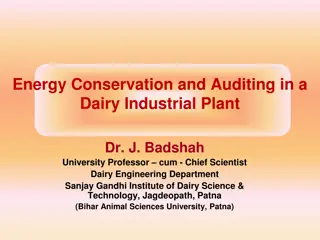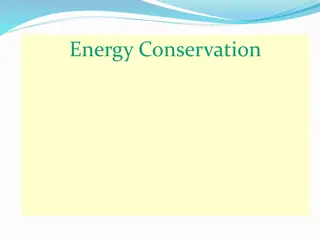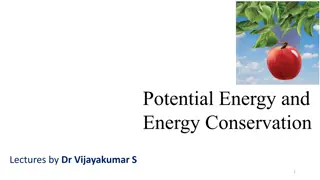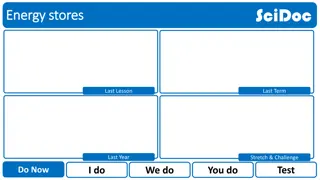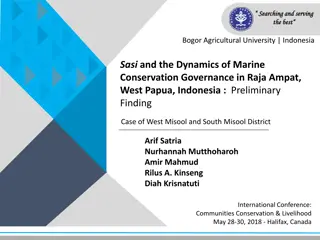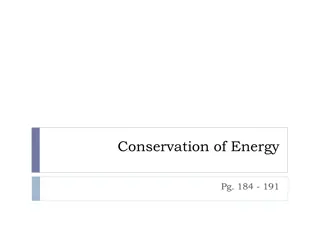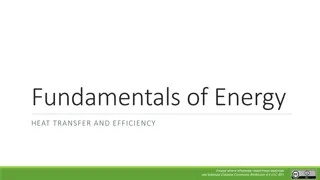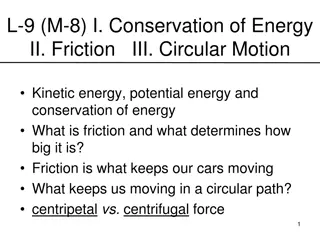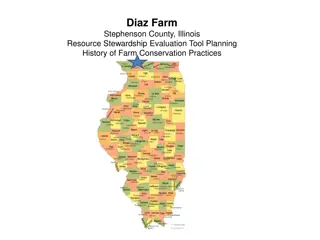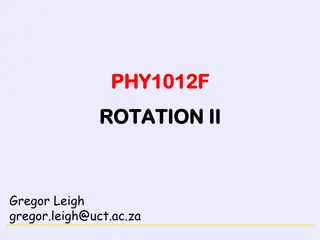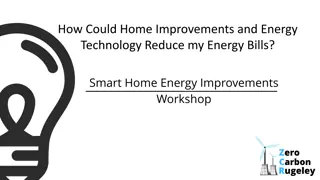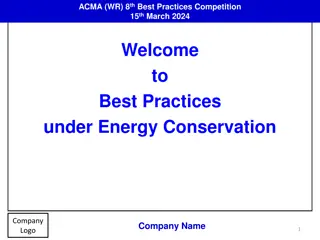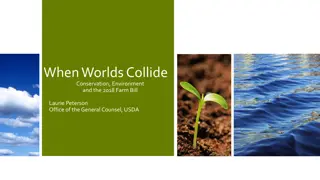Conservation of energy
Conservation of energy is a fundamental principle in physics that states the total energy in a closed system remains constant over time. This concept is applied through various sample problems and examples involving calculations of kinetic and potential energies. Whiteboard illustrations further explain how energy is transformed and conserved during different scenarios such as speeding up or slowing down.
Download Presentation

Please find below an Image/Link to download the presentation.
The content on the website is provided AS IS for your information and personal use only. It may not be sold, licensed, or shared on other websites without obtaining consent from the author.If you encounter any issues during the download, it is possible that the publisher has removed the file from their server.
You are allowed to download the files provided on this website for personal or commercial use, subject to the condition that they are used lawfully. All files are the property of their respective owners.
The content on the website is provided AS IS for your information and personal use only. It may not be sold, licensed, or shared on other websites without obtaining consent from the author.
E N D
Presentation Transcript
Conservation of energy Contents: Definition Conservation of Energy Sample problem 1 Sample problem 2 Whiteboards
Conservation of Energy Total Energy before = Total Energy After Comes from = Goes to Assets = Expenditures Fs + mgh + 1/2mv2 + 1/2kx2 =Fs + mgh + 1/2mv2 + 1/2kx2 Speeds you up work Slows you down work
Example 1 Fs + mgh + 1/2mv2 + 1/2kx2 =Fs + mgh + 1/2mv2 + 1/2kx2 v = 4.5 m/s 250 kg What is its velocity at the bottom? 1.75 m 0 + (250 kg)(9.81 N/kg)(1.75 m) + 1/2(250 kg)(4.5 m/s)2 + 0 = 0 + 0 + 1/2(250 kg)v2 + 0
Example 2 Fs + mgh + 1/2mv2 + 1/2kx2 =Fs + mgh + 1/2mv2 + 1/2kx2 v = 6.2 m/s What is its velocity after the puddle? 890 kg 3.6 m (Puddle - Exerts 3200 N of retarding force) 1/2(890 kg)(6.2 m/s)2 =(3200 N)(3.6 m) + 1/2(890 kg)v2
Example 3 Fd + mgh + 1/2mv2 =Fd + mgh + 1/2mv2 What is its velocity after the puddle at the bottom? v = 4.5 m/s 250 kg 1.75 m Puddle exerts 1200 N of slowing force for 2.30 m 0 + (250 kg)(9.8 N/kg)(1.75 m) + 1/2(250 kg)(4.5 m/s)2 + 0 =(1200 N)(2.30 m) + 0 + 1/2(250 kg)v2 + 0 5.70 m/s
Whiteboards: Conservation of Energy 1 | 2 | 3 | 4 | 5 | 6 | 7 | 8
What speed at the bottom? u = 0 15 kg h = 2.15 m Fs + mgh + 1/2mv2 + 1/2kx2 =Fs + mgh + 1/2mv2 + 1/2kx2 0 + mgh + 0 + 0 =0 + 0 + 1/2mv2 + 0 (15 kg)(9.81 N/kg)(2.15 m) = 1/2(15 kg)v2 v = 6.4948 6.5 m/s
What speed at the top? vi = 8.7 m/s 15 kg h = 2.15 m Fd + mgh + 1/2mv2 =Fd + mgh + 1/2mv2 0 + mgh + 1/2mv2 =0 + 0 + 1/2mv2 + 1/2(15 kg)(8.7 m/s)2 = (15 kg)(9.8 N/kg)(2.15 m) + 1/2(15 kg)v2 5.8 m/s
What speed at the top? u = 8.6 m/s 15 kg h = 4.25 m h = 2.15 m Fs + mgh + 1/2mv2 + 1/2kx2 =Fs + mgh + 1/2mv2 + 1/2kx2 0 + mgh + 1/2mv2 + 0 =0 +mgh + 1/2mv2 + 0 (15 kg)(9.81 N/kg)(2.15 m) + 1/2(15 kg)(8.6 m/s)2 =(15 kg)(9.81 N/kg)(4.25 m) 1/2(15 kg)v v = 5.723 5.7 m/s
What final velocity? u = 4.6 m/s 350 kg Pushes with 53 N for 35 m Fs + mgh + 1/2mv2 + 1/2kx2 =Fs + mgh + 1/2mv2 + 1/2kx2 Fs + 0 + 1/2mv2 + 0 =0 + 0 + 1/2mv2 + 0 (53 N)(35 m) + 1/2(350 kg)(4.6 m/s)2 = 1/2(350 kg)v2 5.6 m/s
u = 5.80 m/s 450. kg h = 1.75 m A 140. gram steel marble compresses a 35.0 N/m spring a distance of 12.0 cm. What is the greatest height the marble reaches above its lowest position? (18.3 cm) What is the speed of the marble when it has risen only 15.0 cm? (0.811 m/s)
What distance will the 15000. N/m spring be compressed when the cart has been slowed to 4.20 m/s? u = 5.80 m/s 450. kg h = 1.75 m Fs + mgh + 1/2mv2 + 1/2kx2 =Fs + mgh + 1/2mv2 + 1/2kx2 0 + mgh + 1/2mv2 + 0 =0 + 0 + 1/2mv2 + 1/2kx2 (450 kg)(9.81 N/kg)(1.75 m) + 1/2(450 kg)(5.8 m/s)2 = 1/2 (450)(4.2)2 + 1/2(15000 N/m)x2 x = 1.23 1.23 m
What speed at the top? vi = 7.1 m/s Accelerator exerts 48.0 N for 2.10 m 15 kg h = 2.15 m Fd + mgh + 1/2mv2 =Fd + mgh + 1/2mv2 Fd + 1/2mv2 =0 + mgh + 1/2mv2 4.66 m/s
Brakes for 4.5 m. Final speed after is 4.0 m/s. What force brakes? vi = 5.8 m/s 15 kg h = 2.15 m Fd + mgh + 1/2mv2 =Fd + mgh + 1/2mv2 0 + mgh + 1/2mv2 =Fd + 0 + 1/2mv2 (15 kg)(9.8 N/kg)(2.15 m) + 1/2(15 kg)(5.8 m/s)2 = F(4.5 m) + 1/2(15 kg)(4.0 m/s)2 99.6 N
Harry Potter exerts a force of 180. N for a distance of 32.0 m on the level speeding up a 980. kg car initially at rest. The car then rolls up an incline. How much elevation will the car gain before it stops? (Neglect friction) 0.599 m
Harry Potter exerts a force of 180. N for a distance of 32.0 m on the level speeding up a 980. kg car initially at rest. The car then rolls up an incline. How much elevation has the car gained when it is still going 2.50 m/s? 0.281 m
A 380. kg roller coaster car initially at rest is launched from the top of a 4.20 m tall hill by a 1920 N/m spring compressed a distance of 6.30 m. What is the speed of the car when it is later at the top of a 11.0 m tall hill? (Neglect friction) 8.19 m/s
v = 3.68 m/s 2.34 kg The hammer pushes in the nail 3.50 mm. (.00350 m). What force did it exert on the nail??? Fs + mgh + 1/2mv2 + 1/2kx2 =Fs + mgh + 1/2mv2 + 1/2kx2 0 + 0 + 1/2mv2 + 0 =Fs + 0 + 1/2(2.34 kg)(3.68 m/s)2 = F(.0035 m) 0 + 0 4530 N
A 125 kg experiment falls 18.0 m and has its velocity arrested in 1.50 m by an air bag. What force does the air bag exert on the experiment in stopping the experiment? 18 m Fs + mgh + 1/2mv2 + 1/2kx2 =Fs + mgh + 1/2mv2 + 1/2kx2 0 + mgh + 0+ 0 =Fs + 0 + (125 kg)(9.81 N/kg)(18.0 m + 1.50 m) = F(1.50 m) F = 15,941.25 0 + 0 15,900 N
What must be the spring constant to give the 115 g marble a velocity of 2.13 m/s on top of the hill if the spring is compressed 3.15 cm? h = .452 m x = .0315 m, m = .115kg Fs + mgh + 1/2mv2 + 1/2kx2 =Fs + mgh + 1/2mv2 + 1/2kx2 0 + 0 + 0 +1/2kx2 =0 + mgh + 1/2mv2 + 0 1/2k(.0315 m)2 = 1/2(.115 kg)(2.13 m/s)2 + (.115 kg)(9.81 N/kg)(.452 m) k = 1553.63 1550 N/m
